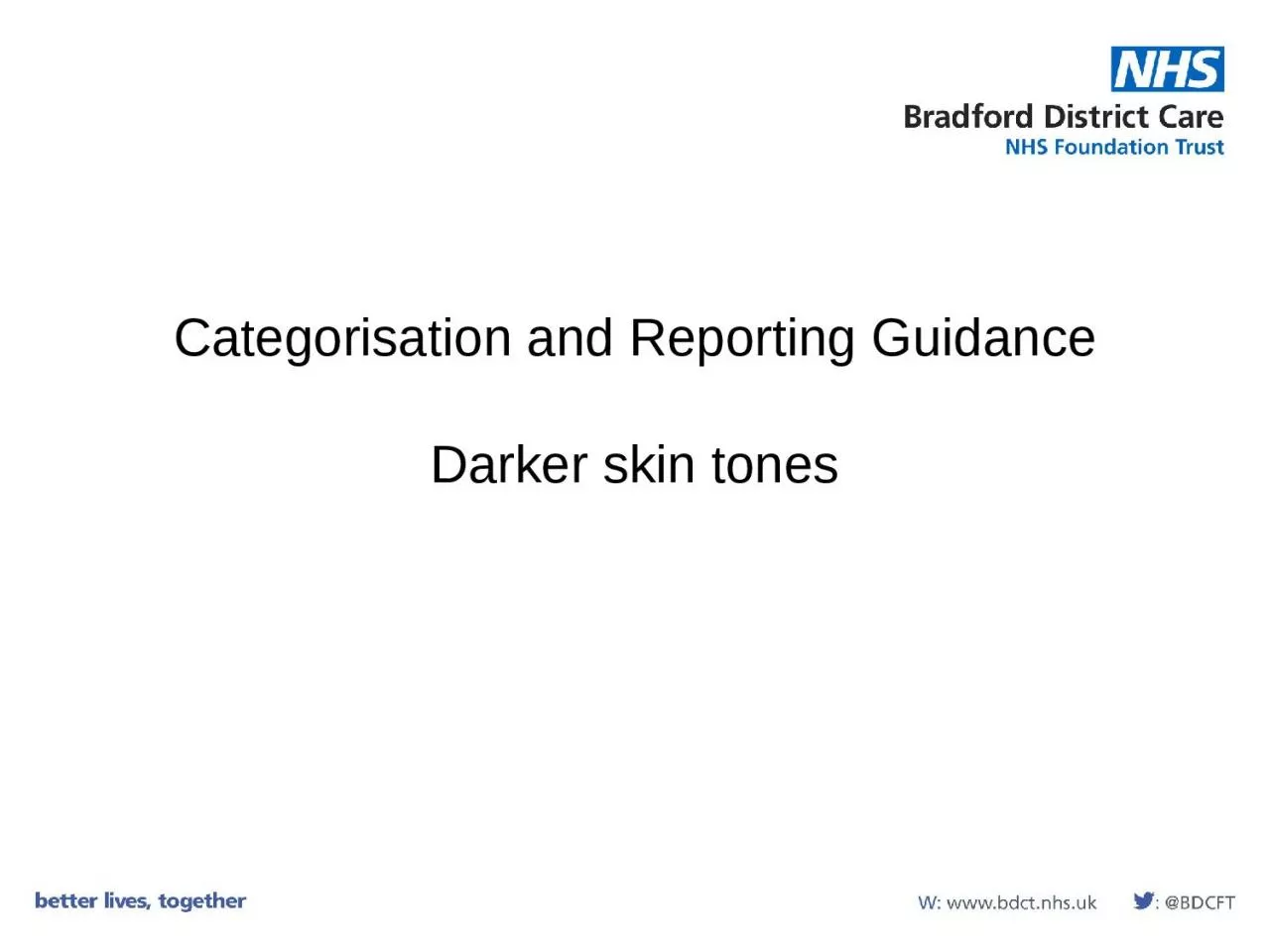

Darker skin tones Darker skin tones can mask the visual indicator of erythema and category 1 pressure ulcers To reduce the risk of these developing into full thickness pressure ulcers in patients with darker skin tones it is essential to recognise the other signs and symptoms that can be observe ID: 1039661
Download Presentation The PPT/PDF document "Categorisation and Reporting Guidance" is the property of its rightful owner. Permission is granted to download and print the materials on this web site for personal, non-commercial use only, and to display it on your personal computer provided you do not modify the materials and that you retain all copyright notices contained in the materials. By downloading content from our website, you accept the terms of this agreement.
1. Categorisation and Reporting GuidanceDarker skin tones
2. Darker skin tones can mask the visual indicator of erythema and category 1 pressure ulcers. To reduce the risk of these developing into full thickness pressure ulcers in patients with darker skin tones, it is essential to recognise the other signs and symptoms that can be observed
3. Category 1 pressure ulcer – Non blanchable erythemaIntact skin with non-blanchable redness of a localized area, usually over a bony prominence. Darkly pigmented skin may not have visible blanching but its colour may differ from the surrounding area. The area may be painful, firm, soft, warmer or cooler compared to adjacent skin. Often difficult to detect in darkly pigmented skin toneMAY INDICATE AT RISK PATIENTS – IR-e NOT requiredTV referral if patient non-concordance identified, to referto non-concordance pathway and flowchart and completemental capacity assessmentCategory 1
4. Category 2 pressure ulcer – Partial thickness skin loss Partial thickness loss of dermis presenting as a shallow ulcer with a red/pink wound bed, without slough. May also present as an intact or open/ruptured serum-filled blister. Presents as a shiny or dry shallow ulcer without slough or bruising(Bruising indicates SDTI)IR-e required – to re report if deterioration to category 3TV referral if patient non-concordance identified, and referto non-concordance pathway and flowchart and completemental capacity assessmentCategory 2
5. Category 3 pressure ulcer – Full thickness skin lossSubcutaneous fat may be visible, but bone, tendon, or muscle will not be exposed. Slough may be present but does not obscure depth of tissue loss and may include undermining or tunnelling. The depth of a category 3 pressure ulcer will vary with location on the bodyIR-e required – to re report only if deterioration to category 4TV referralIf patient non concordant, refer to non-concordance pathway and flowchart and complete mental capacity assessment Category 3
6. Category 4 pressure ulcer – Full thickness tissue loss with exposed bone, muscle or tendonFull thickness tissue loss with exposed bone, tendon, or muscle. Slough or eschar may be present on some parts of the wound bed. Often includes undermining or tunnelling. The depth of a category 4 pressure ulcer can vary dependent on location and can extend into muscle and/or underlying structures (eg fascia, tendon or joint capsule) making osteomyelitis possible. Exposed bone/tendon is visible or directly palpableIR-e required TVN ReferralRefer to non-concordance pathway and flowchart and complete mental capacity assessment if identified patientnon-concordanceCategory 4
7. Unstageable pressure ulcer - depth unknown Full thickness tissue loss in which the base of the ulcer is covered by slough (Yellow, tan, grey, green or brown) and/or eschar (tan, brown or black). Until enough slough and/or eschar is removed to expose the base of the wound, the true depth and category cannot be determinedIR-e required – to re report only if deterioration to category 4TV referralRefer to non-concordance pathway and flowchart and complete mental capacity assessment if identified patientnon-concordanceUnstageable
8. Suspected deep tissue injury - depth unknown Purple or maroon localized area of discolored intact skin or blood-filled blister due to damage of underlying soft tissue from pressure and/or shear. Evolution may include a thin blister over a dark wound bed. The wound may further evolve and become covered by thin eschar. Evolution may be rapid, exposing additional layers of tissue even with optimal treatment. Deep tissue injuries may be difficult to detect in individuals with darker skin tones, the area may be preceded by tissue that is painful, firm, mushy, boggy, warm or cooler compared with adjacent tissue.IR-e required – to re report only if deterioration to category 4TV referralRefer to non-concordance pathway and flowchart and complete mental capacity assessment if identified patientnon-concordanceSDTI
9. Moisture associated skin damage – This can occur due to the presence of any type of moisture on the skin, including incontinence, leakage from a stoma, saliva, wound exudate and sweat. Multiple lesions with diverse edges are typical of incontinence associated dermatitisTHIS CAN INCREASE THE RISK OF PRESSURE DAMAGEIR-e required when acquired in BDCFT only To re report only if deterioration to category 2 and above pressure damage TVN Referral for all non-concordance and refer to non-concordance pathway and flowchart and complete mental capacity assessment MASD